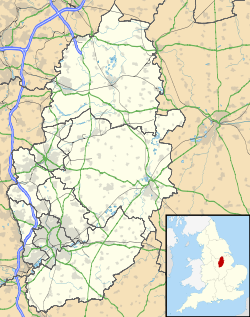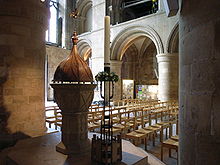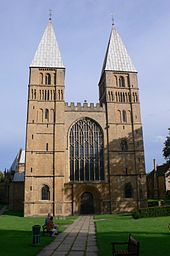- Southwell Minster
-
Southwell Minster Cathedral and Parish Church of the Blessed Virgin Mary 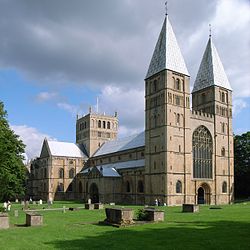
Shown within Nottinghamshire 53°4′36″N 0°57′14″W / 53.07667°N 0.95389°WCoordinates: 53°4′36″N 0°57′14″W / 53.07667°N 0.95389°W Location Southwell, Nottinghamshire Country England Denomination Church of England Website www.southwell minster.org.uk Architecture Style Romanesque, Gothic Years built c.1108-c13.00 Specifications Number of towers 3 Number of spires 2 Administration Diocese Southwell and Nottingham (since 1884) Province York Clergy Bishop(s) Paul Butler Dean John Guille Southwell Minster (pronounced /ˈsaʊθwɛl/) is a minster and cathedral, in Southwell, Nottinghamshire, England. It is six miles away from Newark-on-Trent and thirteen miles from Mansfield. It is the seat of the Bishop of Southwell and Nottingham and the Diocese of Southwell and Nottingham.
It is considered an outstanding example of Norman and Early English architecture.[citation needed] The distinctive pyramidal spires of lead (or Rhenish caps or "pepperpot" spires as they are known locally), the only example of their kind in the United Kingdom,[citation needed] uniquely overlap the footprint of the tower walls and are particularly noteworthy.
Contents
History
Mediæval
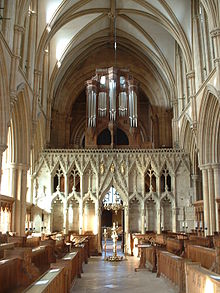 The pulpitum from the quire
The pulpitum from the quire
The earliest church on the site is believed to have been founded in 627 by Paulinus, the first Archbishop of York, on a visit to the town when he was baptising believers in the River Trent. This legend is commemorated in the Minster's baptistry window.[1]
In 956 King Eadwig gave a gift of land in Southwell to Oskytel, Archbishop of York, on which a Minster church was established. The Norman Domesday Book of 1086 recorded Southwell manor in great detail, and the Norman reconstruction of Southwell Minster began in 1108, probably as a gradual rebuilding of the Anglo-Saxon church, starting (as was usual) at the East end so that the high altar could come into service as soon as possible, the Saxon building being dismantled as work progressed. Many of the stones of this earlier Saxon church were reused in the construction of the Norman one. The tessellated floor and late 11th century tympanum in the North Transept are the only pieces of the earlier, Saxon building remaining intact. Work on the nave began after 1120 and the building was completed by c. 1150.
The Minster was built partly as an attached church of the Archbishop of York's Palace (which stood next door and is now ruined). It served the Archbishop as a place of worship and was also a collegiate body of theological learning, hence its designation as a minster. The minster still draws its choir from the nearby school with which it is associated.
The Norman quire was replaced with an Early English building in 1234 because it was too small. The octagonal chapter house, built in 1286 complete with vault in Decorated Gothic style and naturalistic carving of foliage (a masterpiece of 13th century stonecarving including several Green Men), completed the cathedral. The elaborately carved "pulpitum" or quire screen was built in 1350.
Reformation and Civil War
The cathedral suffered less than many others in the English Reformation as it was refounded in 1543 by Act of Parliament.
Southwell is where King Charles the First was captured during the English Civil War. The fighting saw the church seriously damaged and the nave is said to have been used as stabling. The adjoining palace was almost completely destroyed, first by Scottish troops and then by the local people, with only the hall of the Archbishop remaining as a ruined shell. The Minster's financial accounts show that extensive repairs were necessary after this period.
18th century
On 5 November 1711, during a terrible storm, the southwest spire was struck by lightning, and the resulting fire spread to the nave, crossing and tower destroying roofs, bells, clock and organ.[2] By 1720 repairs had been completed, now giving a flat panelled ceiling to the nave and transepts.
Victorian
In 1805 Archdeacon Kaye gave the Minster the Newstead lectern; once owned by Newstead Abbey, it had been thrown into the Abbey fishpond by the monks to save it during the Dissolution of the Monasteries, then later discovered when the lake was dredged.[3] Sir Henry Gally Knight in 1818 gave the Minster four panels of 16th-century Flemish glass (which now fill the bottom part of the East window) which he had acquired from a Parisian pawnshop[4]
In danger of collapse, the "pepperpot" spires were removed in 1805 and only re-erected in 1879-1881. At this time of extensive restoration by Ewan Christian, an architect specialising in churches, the nave roof was also considered unsuitable due to its flatness[citation needed] and was completely rebuilt in the current peaked version[5] and the choir was redesigned and refitted.
Ecclesiastical history
Collegiate church
Southwell Minster was originally served by its Prebendaries. These evolved from the early days of the Minster foundation until there were 16 in existence. This was as early as 1291 when they are all mentioned in the Taxation Roll.
In 1540 the prebends and minster were suppressed. However an act of Parliament in 1543 re-established the colledge and church collegiate of Southwell.
Under an Act of King Edward VI, the prebendaries were pensioned off, and their estates sold. The minster continued as the parish church on the petitions of the parishioners.
By an Act of Philip and Mary in 1557, the Minster and its prebends were again restored as before.[6]
On 2 April 1585 a new set of statutes was promulgated by Queen Elizabeth I and the chapter operated under this constitution until it was dissolved in 1841. The Ecclesiastical Commissioners made provision for the abolition of the chapter as a whole; the death of each canon after this time resulted in the extinction of his prebend. The chapter came to its appointed end on 12 February 1873 with the death of the Rev. Thomas Henry Shepherd, rector of Clayworth and prebendary of Beckingham.[7]
Cathedral
In 1884 Southwell Minster finally became a cathedral proper for Nottinghamshire and a part of nearby Derbyshire (an event whose centenary was commemorated with a royal visit to hand out the Maundy money): the Diocese included the City of Derby until it was divided in 1927, when the Diocese of Derby was formed. Dr George Ridding, the first Bishop of Southwell, designed and paid for the grant of Arms now used as the Diocesan coat of arms. Its creation as a cathedral has led to confusion over the civic status of Southwell. Traditionally it was considered to be a city because of the presence of the cathedral,[dubious ] but in more modern times the traditional definition has not been recognised by government (see city status in the United Kingdom).
The Friends of Cathedral Music was founded in 1956 by the Revd. Ronald Sibthorpe prompted by a decision of the Provost of Southwell to abolish the Saturday choral evensong so that lay clerks could watch the weekly football at Newark-on-Trent.[8]
Architecture
The nave, transepts, central tower and two western towers of the Norman church which replaced the Saxon minster remain as an outstanding achievement of severe Romanesque design. The central tower's two ornamental stages place it high among England's surviving Norman towers. The nave is imposing, with cylindrical columns, large triforium arches and an unaltered clerestory with rows of round windows. The choir is admirable Early English work; though comparatively low the work is of very high quality. In the 14th century the splendid choir screen and the chapter house were added. The polygonal chapter house and its vestibule comprise a Decorated masterpiece with sculptured detail including heads and naturalistic foliage, the latter being unsurpassed in England. The brass lectern of ca. 1500 came from Newstead Abbey and the sanctuary contains some fine Parisian glass of the early 16th century. There is the tomb of Archbishop Sandys of York (died 1588).[9]
Staff
Clergy
- Dean
- Dean: The Very Reverend John Arthur Guille, BTh (Southampton) (since 2006)
- Former Provosts and Deans
The title of Provost was changed in 2000 to Dean.
- William James Conybeare 1931–1945
- Hugh Christopher Lempriere Heywood 1945–1969
- John Francis Isaac Pratt 1970 - 1978
- John Murray Irvine 1978–1991
- David Leaning 1991–2006
- Canons
- Canon Pastor: The Reverend Canon Nigel John Coates, BSc MA (Reading)
- Canon Precentor: The Reverend Canon Jaqueline Dorian Jones, BD MTh (Lond), AKC
- Canon for Education & Learning:The Reverend Canon Edward Pruen, BD(Lond) AKC DPS
- Priest Vicar :The Reverend Canon Professor Alison Milbank PhD (Lancaster), MA(Cantab)
- Bishop's Chaplin : The Reverend Canon Tony Evans BTh BA (Nottingham)
- The Venerable Canon Robin Turner CB, DL, AKC BA MTh FRSA
Lay Staff
- Rector Chori: Paul Hale, MA(Oxon) FRCO ARCM PGCE FGCM FRSCM FRSA FNMSM
- Assistant Director of Music: Philip White-Jones, MA(Cantab) FRCO
- Organ Scholar: Hilary Punnett
- Head Verger: Andrew Todd
Music and liturgy
Much of the worship at the Minster is led by the Minster Choir, a traditional cathedral choir of boys and men, directed by the Rector Chori (Literally "The Ruler of the Choir"), Paul Robert Hale. Choristers are educated at the Minster School, which is unusual among choir schools as it is in the state sector. The Minster Choir has recently attracted international attention thanks to previous head chorister Ben Inman, who was a member of The Choirboys, a "boy band" comprising three cathedral choristers.
There is also a Girls' Choir and the Minster Chorale, a choir of adult volunteers.
The Minster follows the rites of the Church of England and uses the 1662 Book of Common Prayer for the main Choral Eucharist on Sunday.
Per Week during term time the Cathedral Choirs sing:
Sunday
- 09:30 - Family Eucharist (Girls' Choir, Minster Chorale or occasionally Boys and Men)
- 11:15 - Sung Eucharist or Matins (Cathedral Choir)
- 15:30 - Choral Evensong (Cathedral Choir)
Monday
- 17:45 - Choral Evensong (Girls' Choir when not singing Sunday)
Tuesday
- 17:45 - Choral Evensong (Boys Only)
Thursday
- 17:45 - Choral Evensong (Cathedral Choir)
Friday
- 17:45 - Choral Evensong (Cathedral Choir, Unaccompanied)
Saturday
- 17:45 - Choral Evensong (Cathedral Choir)
The Cathedral Choir
In recent years, the choir has broadcast regularly on BBC Radio 3, have recorded CDs, have toured in Europe, have filmed Christmas programmes, and have given world premières of specially commissioned works such as Paul Patterson’s Southwell Millennium Mass. Their most recent tour was in Puglia May 2010.
Choristers
There are usually 16 choristers in the Cathedral Choir. As with most choirs there is a ranking system of Head Chorister; Deputy Head Chorister; Tippet Boys; Senior Singing Boys; Junior Singing Boys and Probationers. There are also Juniors who do not sing with the full choir, but are training to become full choristers.
Lay Clerks/Choral Scholars and Vicar Choral
There are six full-time Lay Clerks in the Cathedral Choir. These are supplemented by a further six men on alternate Sunday evenings and on special occasions, expanding the repertoire and force of the choir.
The Cathedral Girls' Choir
The Minster Girls’ Choir was formed in February 2005 by the then Assistant Organist Simon Bell. The choir is made up of eighteen choristers, under the direction of Philip White-Jones, the Assistant Director of Music, and is designed to complement the Boys’ Choir which has been singing at the Minster for hundreds of years.
The girls are drawn exclusively from the Minster school, beginning at year 7 and progressing through to year 13. They rehearse twice a week, on Mondays, and Thursdays. They currently sing alternately between Evensong on Mondays at 5.45 pm and the 9.30 am Family Eucharist on Sundays.
The choir’s repertoire consists of music written for upper voices. Including music by composers such as Jean Langlais, Charles Wood and George Dyson. In September 2007, the choir sang a commissioned anthem by Andrew Parnell, a former chorister at Southwell, as part of the service of installation of the Dean. Their first tour was to Stavanger in Norway in October 2009, this included concerts and services. They have recently released their first CD, Christus Rex - a selection of music from Lent to Ascension, including Leighton's Easter Sequence.
The Minster Chorale
The Minster Chorale is an adult voluntary choir that sings frequent services throughout the year in the Minster. It consists of up to thirty members who meet to rehearse most Friday evenings during school term times. Currently directed by the Minster's Assistant Director of Music, Philip White-Jones, the Minster Chorale was founded in 1994 by Philip Rushforth and Paul Hale.
The Choir sings a cross-section of the whole repertoire of traditional Cathedral music, including works by Palestrina, Byrd, Mozart, Stanford and Howells.
During the year, the Chorale deputizes for the Minster Choir at half-term, and additionally sings at many of the evening Eucharist services on high feast days, such as Ash Wednesday, Maundy Thursday and Ascension Day. The Chorale takes its share of Christmas duties, singing at Midnight Mass.
The Chorale’s high reputation means that it is also invited to perform occasional concerts and services away from the Minster. In recent years, the Chorale has sung in Rievaulx Abbey, St Mary’s Collegiate Church in Warwick, and Uppingham Parish Church. In July 2005, the Chorale ventured abroad for the first time, singing services at Christ Church Cathedral, Dublin. In the Summer of 2011, the Chorale joined with the Voluntary Choir of Rochester Cathedral to celebrate the music of Rochester composers such as Robert Ashfield, Barry Ferguson and Percy Whitlock. The choir’s regular accompanist is the Minster’s Organ Scholar.
List of Rectores Chori
- Lawrence Pepys 1499
- Rev George Vincent 1519
- George Thetford 1568
- John Mudd 1582
- Thomas Foster 1584
- William Colbecke 1586
- John Beeston 1594
- Edward Manestie 1596
- Francis Dogson 1622
- John Hutchinson 1628
- Edward Chappell 1661
- George Chappell 1690
- William Popeley 1699
- William Lee 1718-1754
- Samuel Wise 1754-1755
- Edmund Ayrton 1755-1764
- Thomas Spofforth 1764-1818
- Edward Heathcote 1818-1835
- Frederick Gunton 1835-1841
- Chappell Batchelor 1841-1857
- Herbert Stephen Irons 1857-1872
- Cedric Bucknall 1872-1876
- William Weaver Ringrose 1876-1879
- W Arthur Marriott 1879-1888
- Robert William Liddle 1888-1918
- Harry William Tupper 1918-1929
- George Thomas Francis 1929-1946
- Robert James Ashfield 1946-1956
- David James Lumsden 1956-1959
- Kenneth Bernard Beard 1959-1989
- Paul Robert Hale 1989-
List of Organists
Assistant Organists:
- Lawrence Frederick Baguley 1897 - 1902[10]
- Sydney Weale 1903 - 1904 (formerly assistant organist at the Church of St. Mary Magdalene, Newark-on-Trent)
- Peter Wood 1958 - 1994
- Philip Rushforth 1994 - 2002 (now Director of Music at Chester Cathedral)
- Simon Bell 2002 - 2008 (now Assistant Director of Music at Winchester Cathedral)
Assistant Directors of Music:
- Philip White-Jones 2008 - current (previously Assistant Organist at Winchester Cathedral)
-
This list is incomplete; you can help by expanding it.
Organ Scholars
Charles Harrison Organ Scholarship
- Matthew Halls 1992-3 (later director of The King's Consort, now the Retrospect Ensemble)
- David Soar 1994-5 (now Professional Operatic Bass)
- David Gostick 1995-6 (now Musical Director of the Bournemouth Sinfonietta Choir and Organist and Master of the Choristers, Wimborne Minster)
- Thomas Wiggall 1997-8 (now Composer and Teacher of Music Surbiton High School, Surrey)
- Anthony Smith 1998-9 (now Research Fellow, University of Sussex)
David McIntosh Organ Scholarship
- Matthew O'Donovan 1999–2000 (now Director of Lower Chapel Music, Eton College)
- Christopher Bucknall 2000-1 (now Director of Music and Organist, St Mary's Church, Barnes)
- Oliver Lallemant 2001-2 (now Assistant Director of Music, Holy Trinity Church, Sloane Square, London)
- Charles Sega 2002-3 (now Organist and Choirmaster, The Episcopal Church of the Atonement, Chicago)
- Stephen Moore 2003-4 (now Organist and Director of Choral Music at Felsted School and Director of Music, St Matthew's Church Northampton)
- Emma Gibbins 2004-5 (now Director of Music St. George's Church, Belfast)
- Simon Earl 2005-6 (now Assistant Director of Music, Wakefield Cathedral)
- Daniel Battle 2006-7 (now Director of Music, All Saints, Carshalton)
- Richard Moore 2007-8 (now Organ Scholar, St John's College, Oxford)
- Peter Holder 2008-9 (now Organ Scholar, St Albans Cathedral)
- Jonathan Turner 2009–11 (now Director of Music, St Stephen's Church, London)
- Hilary Punnett 2011- (previously Assistant Organist, Christchurch Cathedral, Montreal)
Gallery
See also
- Architecture of the medieval cathedrals of England
- English Gothic architecture
- Romanesque architecture
- Church of England
References
- ^ As mentioned by Daniel Defoe, (who visited in 1725) in his journal A tour thro' the Whole Island of Great Britain
- ^ The Cathedral Church of Southwell by Arthur Dimock
- ^ English cathedrals, Patrick Cormack
- ^ Collins guide to cathedrals, abbeys, and priories of England and Wales. Henry Thorold.
- ^ Transactions of the Thoroton Society of Nottinghamshire: Volumes 76-77, 1973
- ^ Notts Villages. W. E Doubleday, as published in The Nottinghamshire Guardian.
- ^ 'Colleges: The collegiate church of Southwell', A History of the County of Nottingham: Volume 2 (1910), pp. 152-161.
- ^ Barrett 2010
- ^ Little, Bryan (1972) English Cathedrals in Colour. London: Batsford; pp. 140-43
- ^ Dictionary of Organs and Organists. First Edition. 1912
Further reading
- Nikolaus Pevsner (1945) The Leaves of Southwell; photographs by F. L. Attenborough. (King Penguin Books; 17.) Harmondsworth: Penguin Books
External links
- Southwell Minster website
- Details and pictures of the screen organ from the National Pipe Organ Register
- Details of the nave organ from the National Pipe Organ Register
- Guide to Southwell Minster with a History of the College of Secular Canons, Grevile Mairis Livett, Printed by John Whittingham, Southwell, 1883
Provosts and Deans of Southwell Provosts William Conybeare • Hugh Heywood • John Pratt • Murray Irvine • David Leaning (became Dean)
Deans David Leaning (previously Provost) • John Guille
Cathedrals of the Church of England Province of
CanterburyBirmingham • Bristol • Bury St Edmunds • Canterbury • Chelmsford • Chichester • Coventry • Derby • Ely • Exeter • Gibraltar • Gloucester • Guildford • Hereford • Leicester • Lichfield • Lincoln • Norwich • Oxford (Christ Church) • Peterborough • Portsmouth • Rochester • St Albans • St Paul's (London) • Salisbury • Southwark • Truro • Wells • Winchester • WorcesterProvince of
YorkCategories:- 956 establishments
- 1150s architecture
- Norman architecture
- English Gothic architecture
- Anglican cathedrals in England
- Grade I listed buildings in Nottinghamshire
- Grade I listed cathedrals
- Church of England churches in Nottinghamshire
- Provosts/Deans of Southwell
- Churches in Nottingham
Wikimedia Foundation. 2010.

